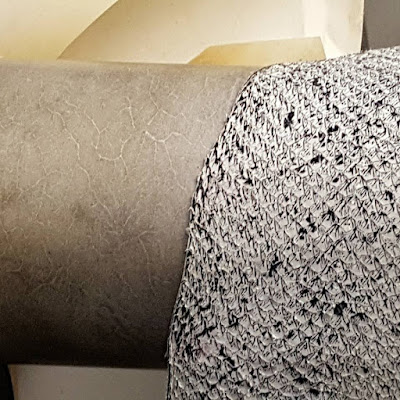Once upon a time, isn't that the way most tales start, I organized my first national traveling exhibition for the Guild of Book Workers. That was the 10/92 - 3/94 traveling Fine Printers Finely Bound Too (Download @ 13MB). Organizing and shepherding that exhibit were an adventure, especially as I had never undertaken anything like that before ... Lots of teachable moments.
Due to unfortunate circumstances, I also ended up designing the catalog by myself with a VERY tight deadline (HAD to be published by the opening), and had no experience doing that sort of work beyond those as high school yearbook editor a little over 12 years earlier. Fortunately, I had an excellent photographer. The rest was up to me. I worked with what I knew, namely WordPerfect 5.0 and the very limited typefaces I had available. Those were the days. Choices were informed by what I was infatuated with at the time. Not everyone was happy, but it was out on time. Again, a learning experience.
 |
| Cover to the printed catalog of Fine Printers Finely Bound Too. (Download @ 13MB) |
One of the things I made sure of was that there were plenty of copies in sheets. Binders crave books in sheets, and there were many wonderful works for inspiration within those pages. I then set about binding 2 copies in 1993. Below the two I bound. The one on the top was for me, the bottom one a commission from the then Guild president who was also the preferred bookbinding supply vendor for most of us. The technique described is what in German is referred to as the Franzband, THE fine binding structure for full-leather bindings. Frank Mowery presented on the technique at the 1990 Guild of Bookbinders' Standards, so read his Journal article, "The Logic and Techniques of German Bookbinding", and see the presentation handout here.
When she retired and sold off her business, that copy disappeared for years before reappearing at an auctioneer where I got outbid.
 |
| The first auction after eBay. I got outbid ... |
It then reappeared on a dealer site for A LOT of $$. I was flattered, but yikes ...
 |
| Dealer listing. I was flattered ... |
Then they retired, sold off their stock, and this book went to another auctioneer.
 |
| The final auction ... Probably could have gotten it for less, but pizza dude rang the bell, so "hail Mary" bid it was. |
This time I was successful, and the prodigal book returned home to be with its sibling.
 |
| Both, reunited after over 30 years ... |
 |
| "Interesting texture on this shark leather, and you did ok binding it ..." |














































